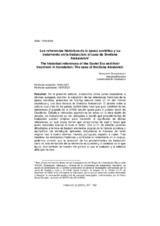Mostrar el registro sencillo del ítem
Las referencias históricas de la época soviética y su tratamiento en la traducción: el caso de Svetlana Aleksiévich
| dc.contributor.author | Savchenkova, Margarita | |
| dc.date.accessioned | 2023-01-24T11:03:24Z | |
| dc.date.available | 2023-01-24T11:03:24Z | |
| dc.date.issued | 2022 | |
| dc.identifier.issn | 1579-9794 | |
| dc.identifier.uri | http://hdl.handle.net/10396/24566 | |
| dc.description.abstract | En el presente artículo, analizamos cómo varios traductores a idiomas europeos abordan la traducción de las referencias históricas de la época soviética, presentes en Vremja sekond hènd(El fin del «Homo sovieticus»), una obra literaria de Svetlana Aleksiévich. El abismo entre la cultura rusa y las de los países occidentales hace que gran cantidad de las referencias al pasado de la URSS resulte opaca para el público lector de Occidente. Debido a reiteradas apariciones de estas en la obra objeto de estudio, los traductores se ven obligados a decidir qué procedimientos de traducción pueden emplear para transmitir el significado de dichas referencias, en qué casos tienen que conservarlas tal cual y hasta qué punto necesitan acercar el texto al lector. Con el fin de detectar posibles dificultades a la hora de traducir elementos propios de la historia soviética y ejemplificar las estrategias aplicadas, estudiamos el trasvase del texto original ruso a cuatro idiomas: francés, portugués, español e inglés. Tras clasificar las referencias históricas y contrastar su tratamiento en el corpus, podemos concluir que la selección de los procedimientos de traducción varía no solo en función de la referencia en cuestión y el contexto en el que figura, sino también en función del género al que el traductor y la editorial atribuyen la obra. | es_ES |
| dc.description.abstract | In this paper, we analyse how several translators into European languages deal with the translation of historical references of the Soviet era, which appearin Vremja sekond hènd(Secondhand Time. The Last of the Soviets. An Oral History), a literary work by Svetlana Alexievich. Because of the gapbetween Russian and Occidental cultures,numerous references to the past of the USSR are obscureto Western readers. Due to their frequent occurrence in the object of the study, translators are required to decide which translation procedures they canuse in order to convey the meaning of each kind of such references, in which cases they have to preserve them and to what extent they need to approach the text to the reader. In view of detecting possible challengesin translating Soviet history elements and illustrating the strategies applied, we studythe translation of the original Russian text into four languages: French, Portuguese, Spanish and English. After classifying the historical references and contrasting their treatment in the corpus, we can conclude that the electionof translation procedures varies not only according to the reference in question and the context in which it appears, but also according to the genre to which the translator and the publisher attribute the literary work. | es_ES |
| dc.format.mimetype | application/pdf | es_ES |
| dc.language.iso | spa | es_ES |
| dc.publisher | UCOPress | es_ES |
| dc.rights | https://creativecommons.org/licenses/by/4.0/ | es_ES |
| dc.source | Hikma 20(2), 127-152 (2021) | es_ES |
| dc.subject | Referencias históricas | es_ES |
| dc.subject | Procedimientos de traducción | es_ES |
| dc.subject | Historia de la Unión Soviética | es_ES |
| dc.subject | Svetlana Aleksiévich | es_ES |
| dc.subject | Historical references | es_ES |
| dc.subject | Translation procedures | es_ES |
| dc.subject | History of the Soviet Union | es_ES |
| dc.subject | Secondhand Time | es_ES |
| dc.title | Las referencias históricas de la época soviética y su tratamiento en la traducción: el caso de Svetlana Aleksiévich | es_ES |
| dc.title.alternative | The historical references of the Soviet Era and their treatment in translation: The case of Svetlana Alexievich | es_ES |
| dc.type | info:eu-repo/semantics/article | es_ES |
| dc.relation.publisherversion | https://www.uco.es/ucopress/ojs/index.php/hikma/index | es_ES |
| dc.rights.accessRights | info:eu-repo/semantics/openAccess | es_ES |

